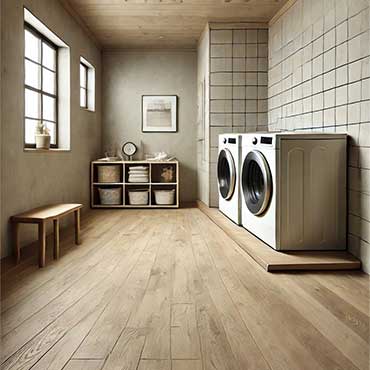Laminate Flooring
Laminate Flooring: A Designer's Choice for Versatility, Durability, and Style
Interior designers and decorators constantly seek materials that balance beauty, practicality, and resilience. Laminate flooring has emerged as a compelling option, capable of transforming any space—from sophisticated living rooms to high-traffic commercial areas—with an array of finishes and styles. But what gives laminate flooring its edge, and why are design professionals increasingly turning to this versatile material?
The Ultimate Flooring Solution: What Is Laminate Flooring?
Laminate flooring is a cost-effective alternative to natural hardwood or stone. Crafted from multiple layers—a durable wear layer, a high-resolution photographic layer that mimics real wood or stone, a core layer for strength, and a stabilizing backing—this flooring combines aesthetic appeal with functional durability. Its top wear layer resists scratches, stains, and fading, making it ideal for spaces with frequent foot traffic. The easy click-and-lock system also enables hassle-free, floating installation without adhesives or nails, saving time on fast-paced design projects.
Features and Benefits of Laminate Flooring
For designers, the allure of laminate flooring lies in its aesthetic versatility. Laminate is available in countless textures, patterns, and finishes, from rustic oak to sleek marble, offering styles that suit a broad spectrum of design visions. Its adaptability allows interior designers and decorators to align flooring precisely with their clients' themes, whether modern minimalism or classic warmth.
In terms of durability, laminate flooring is unmatched in its category. The protective top layer safeguards against scratches and UV rays, preserving the vibrancy of its design over time. For high-traffic areas, this resilience means less worry about wear and tear, while its minimal maintenance requirements—a simple sweep or damp mop—add practical appeal for designers focused on functionality.
Why Laminate Flooring Stands Out
Laminate flooring’s unique combination of affordability and performance is a key differentiator. Designers working within budget constraints can achieve the look of hardwood or stone without the high price tag, making it an excellent choice for luxury on a budget. The flooring's innovation-driven design also lends it superior resistance to scratches, dents, and stains, meeting the needs of spaces that demand longevity.
Additionally, easy installation gives laminate an advantage for decorators facing tight timelines. Its floating installation method reduces project downtime and offers flexibility, allowing for faster and more efficient installations. Customization options—from plank sizes to surface textures—enable designers to tailor the flooring to complement any design aesthetic, providing a unique edge in personalized projects.
Where to Use Laminate Flooring
Laminate flooring works wonderfully in living rooms, dining rooms, bedrooms, and offices, where style and durability are essential. Its ability to deliver comfort and visual impact makes it a natural choice for spaces where aesthetic appeal meets practicality. However, it’s best to avoid standard laminate in areas with high moisture, such as bathrooms or basements, unless selecting a moisture-resistant variety. In these settings, laminate offers the sophisticated look of wood or tile, while holding up to daily use.
Elevate Your Designs with Laminate Flooring
Laminate flooring brings together style, resilience, and cost-effectiveness, making it an essential choice for designers and decorators looking to create impactful, enduring spaces. Its blend of versatility and quality ensures it can meet the demands of even the most discerning clients. With laminate, let your designs transcend expectations and bring any vision to life.
 Blog
BlogLiving Room - Laminate Flooring
Laminate Flooring in the Living Room: A Designer’s Guide to Style and Functionality
This blog post, authored by Arabella Whitethorn, explores the potential of laminate flooring as an ideal choice for living rooms, targeting interior designers and decorators. The living room, a central social and relaxation space, demands flooring that combines visual appeal with practicality. , known for its versatility, cost-effectiveness, and durability, offers a stylish alternative to natural materials like hardwood and stone. Through a detailed analysis of nine critical design considerations—including room purpose, style coherence, durability, and soundproofing—Arabella delves into how laminate flooring can enhance the overall ambiance and functionality of the living room.
For design professionals, this post provides insights into the pros and cons of laminate, with attention to factors such as moisture resistance, eco-friendliness, and budgetary impact. It also highlights how laminate’s ease of installation and customizable finishes can streamline projects while achieving high-end aesthetics. Arabella’s expertise in transforming spaces brings valuable perspective, helping readers make informed flooring decisions that align with both the aesthetic and functional needs of their clients' living rooms.
Learn More Blog
BlogHome Office - Laminate Flooring
Laminate Flooring for Home Offices: Stylish, Durable, and Practical Solutions
offers an exceptional solution for home offices, blending durability, style, and practicality to create an ideal foundation for productivity. This blog post explores why laminate flooring is an increasingly popular choice among interior designers and decorators when designing home office spaces. The article delves into how laminate flooring enhances a home office's functionality while complementing diverse design styles, from minimalist modern to warm traditional. By addressing key considerations such as durability, moisture resistance, eco-friendliness, and acoustic performance, the post provides a comprehensive guide to making an informed flooring choice.
Additionally, the blog highlights laminate flooring's versatility in adapting to various room aesthetics, offering high-end finishes that mimic natural wood and stone at an affordable cost. With insights tailored to professional designers, this post inspires creative applications of laminate flooring, emphasizing its role in creating cohesive, stylish, and highly functional home office environments. Through detailed analysis, practical tips, and inspiring design ideas, the article empowers readers to make impactful design decisions for their next project.
Learn More Blog
BlogLaundry Room - Laminate Flooring
Laminate Flooring in the Laundry Room: Stylish, Durable, and Practical
This article, authored by Arabella Whitethorn, explores the use of in the laundry room, focusing on its design versatility, durability, and practical advantages. The blog addresses critical considerations such as moisture resistance, style coherence, and budget-friendliness, offering professional insights for interior designers and decorators. With detailed discussions on the product’s impact on visual appeal, comfort, and functionality, this post serves as a comprehensive guide to incorporating laminate flooring into laundry room projects while maintaining a high standard of design excellence.
Learn More


























